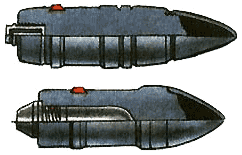
Logo from Scott Cunningham.

Logo from Scott Cunningham.
 common variation of AP, APC, APBC and APCBC projectiles is to provide a small amount of HE (high explosive) within, fused to explode after penetration inside the target, and designated by appending the suffix “/HE”. Only AP, APC, APBC and APCBC projectiles had enough room internally to fit a small amount of HE and the fuse, other types of ammuniton were solid.
common variation of AP, APC, APBC and APCBC projectiles is to provide a small amount of HE (high explosive) within, fused to explode after penetration inside the target, and designated by appending the suffix “/HE”. Only AP, APC, APBC and APCBC projectiles had enough room internally to fit a small amount of HE and the fuse, other types of ammuniton were solid.

A cutaway of an APBC (top) and APBC/HE (bottom) projectile, where the small cavity at the rear contains HE and a base fuse. Any solid projectile, such as the top cutaway, is called “shot”; any projectile with an internal cavity such as the bottom cutaway is called a “shell”. From the Russian Military Zone.
To distinguish between those projectiles carrying HE and those that do not, the term “shot” is used for a solid projectile with no internal cavity; it is a contraction of roundshot and harks back to the early days of artillery. “Shell” on the other hand is used to describe a projectile with an internal cavity which may be used to contain anything (smoke, shrapnel, gas, etc.) but is most commonly used for projectiles carrying HE.
The amount of explosive carried is small because the bulk of the projectile’s mass must be strong enough to achieve adequate penetration. Even so, the penetrating ability of a projectile containing HE is less than that of solid shot. However once penetration has occured, even with such a small amount of HE, the HE filled shell causes considerably more damage after penetration than the simple solid shot.
Developing a reliable and fast acting fuse proved difficult for many countries…
A projectile containing HE requires a reliable and fast acting fuse which would operate even after the tremendous forces encountered while penetrating the target. Several countries found this difficult to develop. Only Germany used HE filled shells exclusively in preference to solid shot for calibres of 20mm and greater during World War II. The effectiveness and reliability of German HE filled shells was much admired, as these two quotes from a British and US report, respectively, on German ammunition from May 1942 shows:
“The German projectiles which have caused the greatest amount of damage to Allied tanks in the Western desert campaigns have been the AP–HE type … These projectiles at long range need only attain a partial penetration and the explosive charge can complete the destruction of at least the tank crew. At closer ranges the destructive effect is very great, where in many cases destruction of the tank is permanent.” 5
“Each German AP–HE round fired may safely be presumed to have put the tank out of action. In this connection it was noted that the fuse functioned perfectly, that is to say it functioned only after penetration and then always in the fighting compartment where the most damage is done. Parts also frequently penetrated into the engine compartment.” 5
In contrast, no British armour piercing projectiles contained HE. Even when the British used USA projectiles for the 75mm gun, such as the M61, they removed the HE filler. In the Churchill Service Instruction Book, it is described as M61 Shot, with the diagram showing that the fuse found in the USA projectile was replaced by a plug holding only the tracer.6
 Sub-calibre Ammunition Part 1 General Design
Sub-calibre Ammunition Part 1 General Design
Do you like this web site? Please rate it between one and ten, with ten being the best:
Ratings are submitted to: The Wargames and Military History Search Engine.
Copyright © 2000 David Michael Honner. E-mail: GvA@wargamer.org.